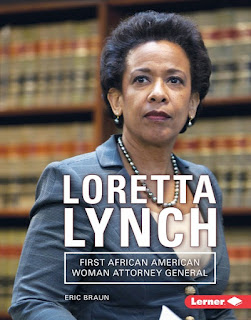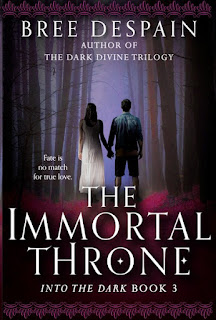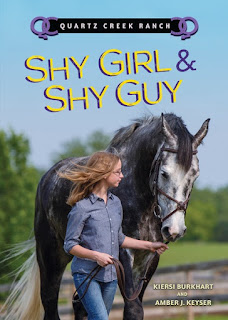new posts in all blogs
Viewing Blog: Lerner Publishing Group, Most Recent at Top
Results 26 - 50 of 1,215
Lerner Publishing Group's blog
Statistics for Lerner Publishing Group
Number of Readers that added this blog to their MyJacketFlap:
It is finally Friday, and we're kicking off a Goodreads giveaway for a Spring 2017 title: Camp So-and-So by Mary McCoy. We'll be sending five advanced review copies to five lucky winners, so throw your hat in the ring for an early Christmas present!
Twenty-five campers. Five cabins. One very dangerous summer camp. Cabin 1 must face off against their ultimate rivals, the posh campers across the lake—who may be more dangerous than they seem.
Cabin 2 is being stalked by a murderous former camper.
Cabin 3 sets off on a quest to break an age-old curse.
Cabin 4 will meet their soul mates—who also pose a deadly threat.
And Cabin 5 . . . well, it might already be too late for Cabin 5.
This is no ordinary camp. Survival will require courage, cunning, and perhaps even magic.
And the hot dogs are terrible.

In December of every year, at venues large and small, people flock to see performances of The Nutcracker. In The Nutcracker Comes to America, Chris Barton tells the story of how this ballet, which originated in Russia, came to the United States and was first performed in the middle of the twentieth century. Gorgeous illustrations from Cathy Gendron help bring this story to life.
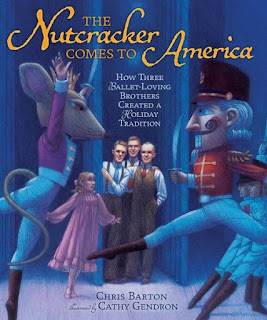
But where did the story of The Nutcracker come from? The answer takes us back two hundred years, when Prussian author E.T.A. Hoffmann wrote "Nussknacker und Mausekönig," which we know in English as "The Nutcracker and the Mouse King." In this story, a young girl named Marie falls in love with a nutcracker doll who comes to life in her dreams. During one dream, a terrible battle takes place between the nutcracker and the mouse king and Marie falls and cuts her arm. Maurice Sendak said of the original story, "It had bite and muscle, the way the Grimm fairy tales do."
So obviously what happened next is that this story was adapted into the ballet, right? Wrong.
Next, French author Alexander Dumas--known for works including The Three Musketeers and The Count of Monte Cristo--adapted Hoffmann's story, making it a bit less dark than the original tale. At the end of Hoffmann's story, Marie decides to marry the nutcracker and become his queen, but in Dumas's version, she returns to her home and family.
Dumas's story was then adapted into a ballet with choreography by Marius Petipa and Lev Ivanov and music by Peter Ilyich Tchaikovsky. As best I can tell, this is the point at which our protagonist Marie is rechristened Clara. In 1892, a week before Christmas, The Nutcracker ballet premiered at the Mariinsky Theater in St. Petersburg, Russia.
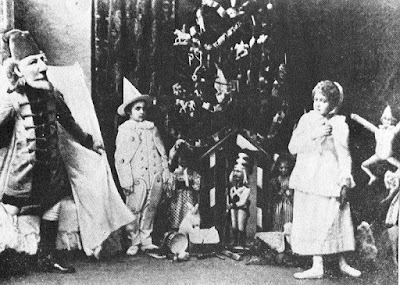 |
| Photo from the first act of the 1892 Nutcracker |
The ballet was an immediate hit, right? Wrong. A reviewer for the St. Petersburg Gazette described it as, "the most tedious thing I have ever seen."
More than thirty-five years later, in 1919, Moscow's Bolshoi Ballet puts on a new production of The Nutcracker, and that one was better received.
So who brought this Russian ballet to the United States? Why, three brothers from Utah! These weren't just any brothers, mind you, they were the Christensen brothers, and they'd been dancing for years before they first staged the full ballet in San Francisco on Christmas Eve, 1944.
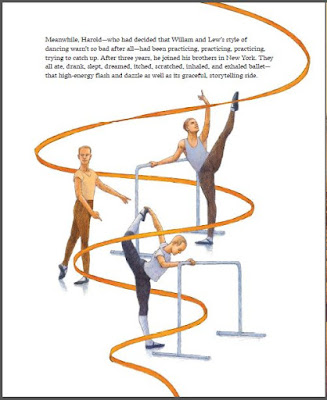 |
| The Christensen brothers, as depicted in The Nutcracker Comes to America |
The ballet was a total success, right? Wrong again!
The San Francisco Ballet performed The Nutcracker for the second time in 1949, and it was at that point that its popularity began to spread and it became a beloved annual tradition. And to think it all started with a story published 200 years ago!
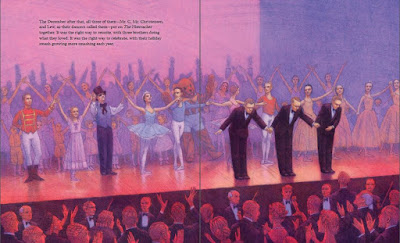 |
| Interior spread from The Nutcracker Comes to America |
Bonus fun fact: Maurice Sendak created the sets and libretto for a version of
The Nutcracker ballet, which the Pacific Northwest Ballet first performed in 1983. You can read more about it--and see some great photos--
here.

How to Be an Earthling® is a Moonbeam 2016 Gold Medal Winner in the Best Book Series—Chapter—Book category! The first title in the series, #1 Spork Out of Orbit is also a Silver Medalist!
After crash landing his spaceship on the school playground, Spork joins Mrs. Buckle's third-grade class to fulfill his mission of earning a Galaxy Scouts Explorer Badge! Spork has a lot to learn about what it means to be an earthling. Rules like respect, responsibility, and honesty are strange and unheard of to Spork! In this humorous and heartfelt series, each book focuses on a positive character trait and encourages children to think about how their words and actions affect others.
Praise for the How to Be an Earthling® series:
"Both this book and the series would be good additions for collections that need additional early chapter books. Recommended."�School Library Connection
Find the complete series
here!

By: Amy McGuire,
on 11/8/2016
Blog:
Lerner Publishing Group
(
Login to Add to MyJacketFlap)
JacketFlap tags:
children,
health,
kids,
education,
environment,
election,
eBooks,
civil rights,
eBook,
activism,
political,
justice,
Taking Action,
"Lerner Digital",
Add a tag
Special thanks to Jeff Mitchell for the following post!
Election Day, the culmination of an 18-month (give or take) campaign season.
Is that all it was? It seemed much, much longer…
Still, whether you scoff at the extended campaigning and 24/7 analysis as nothing but sound and fury; or whether you’re a political junkie, sleep deprived from too many late nights wrapped in the glow of cable TV or Twitter, consider that for many school-age students, this could be a time of discovery. When else are topics such as government, policy, education, the economy, and justice discussed as often as they are during an election year? When else does the conversation place such topics directly in the context of everyday lives, as it often attempts to in an election year? And even beyond the election, recent protests, from New York City to rural North Dakota, show there are many people reacting to circumstances in their lives and coming together to voice their concerns.
So how does all of this impact student lives? What does it mean to be a citizen? What does it mean to be an activist? What are the current political and social concerns in the World? Can students, most of whom too young to vote, engage politically in other ways?

For students interested in such questions, Lerner Digital’s new
Who’sChanging the World series of eBooks examines some of our most pressing issues—individual rights, the environment, schools, health—and profiles motivated individuals who brought about change. Written for students in Grades 4-6, these eBooks tell the stories of people who didn’t always start out as activists, per se, but who happened to observe something unfair or wrong while traveling on their various walks of life and took action to do something about it. Many stories even feature young students whom the powers that be maybe didn’t take as seriously as they should have! All profiles demonstrate examples of change brought about by motivated individuals choosing to observe, learn, and act.
Do you ever worry about people being treated unfairly? Do you wish you could help make things better? The civil rights activists profiled in this book do that every day. One teenager organized a hunger strike and a protest of 120,000 people to demand voting rights. Three friends started the Black Lives Matter movement by commenting on social media. Another activist started a petition that asked teen magazines to stop altering photos of girls' bodies. And a farmworker organized other farmworkers and consumers to ask for higher wages and better working conditions.
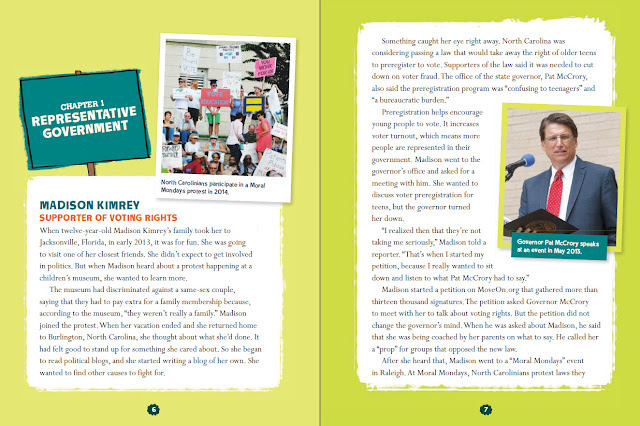
See how environmental activists take action in many ways: One eleven-year-old sold drawings of birds to raise money to help clean up an oil spill. A poet presented her writing against nuclear testing and rising sea levels to the United Nations. One activist coordinated murals and street theater to make people aware of health problems caused by local power plants. And a journalist wrote about the process of raising, processing, and selling beef, which changed how some meat is processed.
Have you ever wished you could stop the spread of diseases? Or help fight hunger? It can be as easy as taking a picture of your school lunch and posting it online. That's what a nine-year-old in Scotland did to raise awareness about healthy eating and hunger. One young boy talked to his senator about health care. Another girl used animation skills to start a conversation about autism. These kids are all activists for health. They noticed a problem, and they did what they could to raise awareness and fix that problem. Read their stories about how they worked to improve health, and learn how you too can be an activist.
Do you ever think about the kids who don't have school supplies? Do you wonder what you could do to make their school year better? The education activists in this book saw problems like this one, and they wanted to make a change. A seven-year-old in Canada made sure that kids in Ethiopia had pencils. A girl in Pakistan risked her life to make sure girls could go to school too. A second grader in Minnesota went to the governor to help end bullying in his state. Discover more about the education activists who are fighting to give kids a better education.
Explore the stories of these inspiring kids and adults, and learn how to start making a difference yourself!

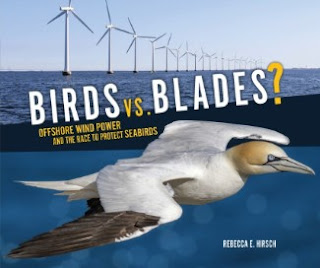
Here's Rebecca:The idea to write Birds vs. Blades? came during a 2013 phone call with seabird biologist Iain Stenhouse. Iain works at the Biodiversity Research Institute, and I was interviewing him for a magazine story I was writing about a bird that lives at sea. Toward the end of our conversation, Iain told me about a research project he was involved in. Scientists were using high tech tags to track mid-Atlantic seabirds and learn more about their movements. The work was urgent, because the federal government and developers wanted to build offshore wind farms along the mid-Atlantic coast. (An offshore wind farm is a cluster of wind turbines, each as tall as a 30-story building.) To protect seabirds, developers would need to build wind farms away from migration corridors and key bird habitat. But no one know where exactly the birds traveled and lived in that part of the ocean. To solve the mystery—and keep seabirds safe—scientists were capturing birds from a small boat on the winter ocean at night and tracking the birds using surgically implanted satellite tags.
I was intrigued. I thought the project had many elements that would make an interesting book: at-risk animals that survived in an extreme environment; a mystery that urgently needed to be solved; and the use of cutting edge methods to try to solve the mystery. There was also an important environmental issue: how can we keep seabirds safe while developing the ocean for clean energy?
I began to research the story. Very little had been written about the project, which meant I would have to learn almost everything through interviews with the scientists who were carrying out the work. Each of the men and women I interviewed was passionate about wildlife preservation and generous with their time. One biologist was, at the time I emailed him, tagging bats in Maine’s Acadia National Park, far out of cell phone range. In order to talk with me, he left the park on his day off, drove to a nearby town, and talked to me by phone from a coffee shop.
I was invited to tag along on some nighttime missions to capture seabirds. From my interviews, I had heard stories of being on a small boat in choppy water, icy rain, blinding snow, and dangerous fog. I gulped and said yes.
 |
| Rebecca Hirsch (right) ready for her scientific adventure! |
On a gray March day, I drove from my home in Pennsylvania to a house in Cape Charles, Virginia, which the crew was using as a base for some capture missions on the Chesapeake Bay. As the sun went down, I dressed myself in layers of clothing to stay warm, then wrestled my way into a fishy-smelling survival suit. The suit would keep me warm, afloat, and visible in case I fell overboard. I nervously joked with the boat crew about that and tried not to think about it.
That night the weather was rainy and foggy. The crew hoped the fog would lift—in it they couldn’t see any birds—but eventually they gave up without capturing anything. So I stayed on for another day. The next night was clear and calm, and the crew’s luck improved. I found that capturing birds was thrilling work to witness. I gripped the rail when we raced across the water in pursuit of a low flying bird. I watched in awe as the team worked in harmony—scooping birds out of the water, weighing and measuring them, and placing each one securely in a plastic tub for transport to shore.
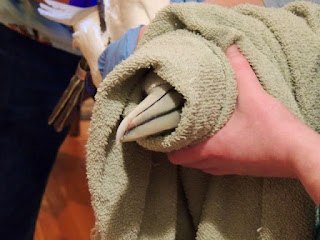 |
| Towel = less stress for the bird |
Later I watched as a team of veterinarians examined each bird, wrapping the head in a towel to ease the bird's stress. As veterinarian Scott Ford performed surgery and implanted a tag, he explained each step and stressed how important it is to protect the bird’s feathers, which are critical to survival. Careful handling could make the difference between life and death once the bird was released back into the water.
 |
| A whole team helps with tagging a bird. |
I’m very proud of the book that resulted. My hope is that through Birds vs. Blades? Offshore Wind Power and the Race to Protect Seabirds, children will be exposed to the real-world environmental challenge of keeping the ocean safe for birds while developing offshore wind power. I hope you enjoy it too!
NOTE: For more from Rebecca, check out this blog post. 
Happy Friday! Congratulations to Marty C., who's won The Atlas of Cursed Places series. Marty, please send your address to [email protected] so we can get your books in the mail.
What are you doing next Tuesday? We'll be hitting the polls! Election day is looming, and we have several titles and series that are perfect for teaching young readers and future voters about presidents, elections, and government:
Grades K-2
This set in the trusted First Step Nonfiction brand explains how government works, what its basic functions are, and how it affects our daily lives. From elections to citizenship, these titles will help young readers understand the key concepts of government. Bright, interesting photos align closely with the text on each page, helping readers decode and comprehend the sentences.
Download a free teaching guide and worksheets
here.
Grades 3-5
As part of the Searchlight Books™ collection, this series sheds light on an important civics question—how does government work? Informative text, interesting photos, and useful examples will help you find the answer. The six books in the series cover everything from the Declaration of Independence to the Judicial Branch to getting elected yourself.
Download a free teaching guide and worksheets
here.
Grades 4-8
On April 27, 2015, a packed Senate gallery watched as Loretta Lynch became the first African American woman to be named US attorney general.
Long before Lynch became attorney general, she found herself immersed in politics. When she was fourteen, her father ran for mayor of Durham, North Carolina. This inspired a passion for politics in Lynch. Upon graduation from law school, Lynch quickly rose through the ranks at a high-powered law firm, and eventually she pursued a career as a top federal prosecutor. This position gave her the professional boost she needed to become attorney general of the United States. Follow Lynch's journey from a young law student to the nation's top legal adviser.
Grades 6-8
What's going on behind the scenes during an election? Readers will explore the inner workings of our political system from a critical thinking perspective. Each book examines key factors that affect the outcome of an election, such as campaign funding, media coverage, the influence of political parties, and the electoral college system. Readers will learn about questioning their sources, analyzing arguments, examining differing points of view, and other media literacy skills.
Download a free research project assignment pdf
here.
Grades 6-12
Examine the professional and personal lives of eight of America's most influential presidents. Readers will investigate the key ideas behind their presidential platforms, analyze the policies they made in office, and evaluate how they shaped and were shaped by history.
●
And, if election fatigue has set in, here's a shamelessly fun YA novel for you to pick up:
After 17-year-old Brooks agrees to be a stand-in Homecoming date for a friend's geeky but wealthy cousin, he realizes becoming a rent-a-date for the socially awkward could help him earn college money. What's the harm?
"The Stand-In has a John Hughes-esque feel and several positive, subtle themes woven throughout that will leave teen and adult YA readers with the good vibes of story satisfaction at the end."

"Fate is no match for true love."
From the jacket copy:
Daphne Raines knew it was risky to enter the underworld to save the love of her life, Haden, who had sacrificed his own honor as an Underlord for her sake. But she could never have predicted that she'd end up betrothed to Haden's conniving half-brother, Garrick, new King of the Underrealm—and bound to his dark world.
Even worse, Haden is banished to the mortal realm, and has just days to live as poison takes over his body and mind. Only Daphne's kiss can save him, but how can she escape Garrick and reach Haden in time? Surprises lurk around every corner in the final chapter of this epic romance story, as Haden and Daphne fight to fulfill their destinies.
After working with Bree through the editorial process on this action-packed romp, I recently caught up with her to give our readers some insights into the series.
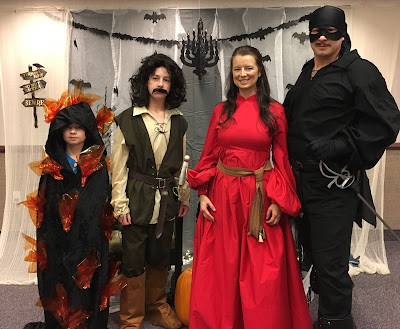 |
| I also got this amazing photo of Bree and family dressed up as characters from The Princess Bride for Halloween. Perfect! |
The Into the Dark series is a modern adventure and romance based on the Greek myth of Persephone, the daughter of Demeter and Zeus, and Hades, the god of the Underworld. What inspired you to write an epic story based on that myth in particular? And how did music become such a big part of your modern adaptation?
Music is a big part of my adaptation because music was my inspiration. I used to be obsessed with the song, "I Will Follow You Into the Dark" by Death Cab for Cutie. I used to listen to it on a loop in my car while running my errands. To me the song is about being willing to follow someone into the unknown for the sake of love. This got me thinking about what it would be like to follow someone into the dark, or what it would be like to have to ask the person you love to follow you into the unknown. These questions made me think about about two of my favorite Greek myths: Hades and Persephone, and Orpheus and Eurydice (the story about the great musician who traveled into the Underworld to try to save his recently deceased bride). Haden was inspired by Hades, tasked with trying to convince Daphne to travel with him to the Underrealm, while Daphne is a mix of Persephone and Orpheus--which is where her musical powers come from. I loved the idea of using music as a super power.
Persephone doesn’t get much agency in the original myth, as she's kidnapped and tricked by Hades. In contrast, the Into the Dark heroine, Daphne, is a strong, modern young woman who isn’t about to let anyone but herself determine her fate. How did you shape her character? How did that affect the shape of Haden’s character?
What's interesting is that in the earliest (lesser known) versions of the Persephone myth, she actually was a strong, powerful, character who willingly chose to go into Underworld of her own free will because she had compassion for the dead and saw the realm's need for a queen. According to many scholars, her story was changed over time because the idea of a young woman willingly choosing to leave her home and family in exchange for power was considered to be "dangerous" by patriarchal societies. In writing Into the Dark, I wanted a chance to give Persephone her power back. I wanted Daphne to be the embodiment of free will, while Haden comes from a society where they believe fate dictates all of their actions. It was fun to let them butt heads over their different ideologies--as well as many other things. :)
Each book in this trilogy is its own epic adventure. What was your process like in laying out and writing the series? Did you have the final paragraph of The Immortal Throne, the last book, written from the start (a la J.K. Rowling and Harry Potter)? A rough outline for each book? What types of snags did you hit along the way in terms of character building, world building, or plot execution?
I originally thought the story was going to be one book, but when my outline came in at over 40 pages long, my agent and first editor helped me realize that it was actually a trilogy. I then had to take that massive outline and break it into three parts. However, I didn't want it to read like one book cut into three sections, so the biggest challenge was to make sure each book in the trilogy had its own satisfying character and story arcs. I always want my characters to learn and grow in some way in each book in the series.
You have many enthusiastic fans, and you often have opportunities to meet them face to face at conventions such as Salt Lake Comic Con and bookstore events. What kinds of feedback from readers stick with you most?
I am so flattered and excited every time I hear from a reluctant reader that one of my books got them interested in reading for the first time. I have a reading disability and I often struggled when reading difficult books as a child, so I work hard to make sure my books are fun and accessible while still tackling complex topics. Nothing makes me happier than hearing, "I didn't like to read until I found your book. Now I read all the time."
Who was your favorite character in this series to write? Why?
Hands down, my answer has to be Haden. He is my most favorite character to write out of all of my books so far. I love the idea that he is this stoic Underrealm prince, taught to hide his emotions, who is suddenly thrust into the chaos and hotbed of teen angst that is a modern day high school. He is told that in order to convince Daphne to return with him to the underworld, he has to get her to fall in love with him--and yet he has never really even met a girl before and has no idea what love is. He is the ultimate fish out of water. I had so much fun writing about all of the mistakes he makes trying to navigate this new life.
What advice might you pass along to aspiring writers of epic fiction, or aspiring writers in general?
This is my writing mantra: "Great books aren't written--they're revised!" First drafts are inherently crappy. Revision is where the magic happens. I meet so many writers who get hung up on the idea that their first draft needs to be perfect (or they think it's perfect and don't want to change anything). Give yourself permission to write a crappy first draft, and be willing to make the changes later that will make it great.
What’s up next for you?
I'm trying my hand at a middle grade time travel adventure story. About a year ago, my boys asked me if I would write a story for them, so I told them about an idea that I have been mulling over for the last seventeen years. (Yes, seventeen!) They were excited by the idea and ended up sitting with me for the next six hours, helping me plot out the story. The whole thing has become a family affair with my husband joining me as my co-author and my sons regularly contributing ideas for cool gadgets and gags. It's the most fun I've ever had writing a book!
Thanks so much, Bree!

By: Amy McGuire,
on 11/1/2016
Blog:
Lerner Publishing Group
(
Login to Add to MyJacketFlap)
JacketFlap tags:
elections,
voting,
media,
election year,
vote,
political,
lobbyists,
Election Day,
special interests,
political party,
Inside Elections,
Presidential Races,
Add a tag
Special thanks to Spencer Hanson for the following post!
The general election is but a week away, as well as the kickoff for campaign 2020. But jokes aside it seems like election season never ends anymore, so it is important to know the election process inside and out to avoid being misled. Do you think you a are savvy informed voter? Do you understand how the voting process works in detail? Who the big players are? Even if you think you do, you are sure to find some surprises and insight while reading Lerner Digital's new 2016 series, Inside Elections. These eBooks cut through the bias to give you the information you need to analyze candidates, political parties, special interests, the media and the voters themselves. Readers will learn about questioning their sources, analyzing arguments, examining differing points of view, and other media literacy skills. There is great potential for some cool assignments for students to apply what they have learned to actual election analysis.
by Sandy Donovan
 Special interest groups, lobbyists, political action committees, campaign finance reform—if people on the news are arguing about these subjects, it's probably an election year. Billions of dollars flow through special interest groups to fund campaigns at local, state, and national levels. This year just over 2 billion alone has gone into the combined campaigns of the presidential front-runners, Hilary Clinton and Donald Trump. Donors, corporations, and committees have the potential to greatly influence political candidates and election results, so the rules surrounding special interest groups and campaign funding should be of great concern to all citizens. Examine opposing viewpoints on some of the key issues and consider for yourself who has—and who should have—a say in the election process.
Special interest groups, lobbyists, political action committees, campaign finance reform—if people on the news are arguing about these subjects, it's probably an election year. Billions of dollars flow through special interest groups to fund campaigns at local, state, and national levels. This year just over 2 billion alone has gone into the combined campaigns of the presidential front-runners, Hilary Clinton and Donald Trump. Donors, corporations, and committees have the potential to greatly influence political candidates and election results, so the rules surrounding special interest groups and campaign funding should be of great concern to all citizens. Examine opposing viewpoints on some of the key issues and consider for yourself who has—and who should have—a say in the election process.
by Sandy Donovan
 The frenzied news coverage during a political election is unstoppable. Political ads bombard you from every source—websites, TV, radio, and print. Then there are the memes, links, and video clips that show up through social media. Are these just annoyances, or do media messages actually shape an election's outcome? News outlets, campaign staff, and even members of the public use many forms of media for different purposes: to explain candidates' platforms, to explore issues, to expose controversy, and more. Some messages are biased, while others try to be balanced. Examine opposing viewpoints on some of the key issues involving media's role and consider for yourself what power media has to influence the election process.
The frenzied news coverage during a political election is unstoppable. Political ads bombard you from every source—websites, TV, radio, and print. Then there are the memes, links, and video clips that show up through social media. Are these just annoyances, or do media messages actually shape an election's outcome? News outlets, campaign staff, and even members of the public use many forms of media for different purposes: to explain candidates' platforms, to explore issues, to expose controversy, and more. Some messages are biased, while others try to be balanced. Examine opposing viewpoints on some of the key issues involving media's role and consider for yourself what power media has to influence the election process.
by Stephanie Sammartino McPherson
 When an election is coming up, you usually expect a face-off between the two major US political parties—Democrats and Republicans. It's easy to forget that there are numerous minor parties—and even groups within a single party—that have different goals. Why do we need political parties? In modern elections, they are important in shaping candidates' positions on issues, determining who is nominated to run on a party ticket, and working behind the scenes to influence an election's outcome. Examine opposing viewpoints on some of the key issues surrounding political parties and consider for yourself the power they hold in the US election process.
When an election is coming up, you usually expect a face-off between the two major US political parties—Democrats and Republicans. It's easy to forget that there are numerous minor parties—and even groups within a single party—that have different goals. Why do we need political parties? In modern elections, they are important in shaping candidates' positions on issues, determining who is nominated to run on a party ticket, and working behind the scenes to influence an election's outcome. Examine opposing viewpoints on some of the key issues surrounding political parties and consider for yourself the power they hold in the US election process.
by Robert Grayson
 On election night, all eyes are on the ballot tallies to see which candidates come out on top. But the actual voting process begins much earlier. Years before an election, candidates recruit supporters—voters—to work on their campaign and win support from other voters. Then political party members vote in primaries and caucuses to determine which candidates will represent their party in the general election. Finally, the general election takes place, but the voting process is not complete until members of the Electoral College cast their votes as well. Examine opposing viewpoints on some of the key issues in the election process and consider for yourself the responsibilities and challenges of voting in a US election.
On election night, all eyes are on the ballot tallies to see which candidates come out on top. But the actual voting process begins much earlier. Years before an election, candidates recruit supporters—voters—to work on their campaign and win support from other voters. Then political party members vote in primaries and caucuses to determine which candidates will represent their party in the general election. Finally, the general election takes place, but the voting process is not complete until members of the Electoral College cast their votes as well. Examine opposing viewpoints on some of the key issues in the election process and consider for yourself the responsibilities and challenges of voting in a US election.
Remember the 8th of November, but never forget that Lerner Digital wants its readers to understand why!

Happy Friday, and happy (almost) Halloween! Congratulations to Sara Pavone (@SaraSPavone), who's won a copy of Stone Cold. Sara, please send your address to [email protected] so we can get your book in the mail.
In honor of the season, we're giving away a Halloween-appropriate series: The Atlas of Cursed Places.
Places can sometimes have more secrets than people. The six high-interest titles follow high school students who are at the mercy of a cursed place—until, that is, they find The Atlas of Cursed Places at the library. Written at a low reading level, this series is perfect for struggling and reluctant readers, as well as English language learners.
Here are three ways you can enter for a chance to win:
- leave a comment on this post that includes your first and last name
- send an email to [email protected] that includes your first and last name
- tweet this line: Tweet for a chance to win The Atlas of Cursed Places from @LernerBooks! bit.ly/1OrSN
US entries only, please. We'll announce the winner on the blog on Friday, November 4. Good luck!

In its starred review of Plants Can't Sit Still, Kirkus Reviews
praised the "colorful, exuberant illustrations [that] work impressively with the text." Today on the blog, illustrator Mia Posada talks about the process of creating the art and shares sketches from each step in the process.
The fun and poetic text of
Plants Can't Sit Still by Rebecca E. Hirsch immediately inspired my imagination, and since one of my favorite subjects to illustrate is flowers, I was excited to take on this project!
The first thing I did after receiving the manuscript for
Plants Can’t Sit Still was research. After all, I had never heard of the Asian climbing gourd, and who knows what a beggar-tick, squirting cucumber [see below], or sensitive plant look like offhand?
One if the things I enjoy about illustrating is that I’m always learning about new things. I collected a big pile of photos of all of the plants I would be illustrating from books and the internet.
Once I had enough source material I began sketching. I started by laying out the book from start to finish with very quick thumbnail sketches [as seen below]. They help me begin to visualize the general look and feel of the book.
Next, I made small sketches (about 4 by 8 inches) where I began to develop the layout of each page. This is where I started to plan the composition, text placement and flow of the book from one page to another.
Finally, I moved on to the full-sized, detailed sketches. Here I figured out and put together all of the elements of the illustration. After feedback on the sketches from the editorial and design teams, I was ready to begin the final artwork.
Since illustrating
Guess What is Growing Inside This Egg, I have enjoyed working in a combination of watercolor and collage. I begin by painting the background of the illustration (if there is one) with watercolor. For the collage elements I like to use white Unryu paper that I paint with watercolor or gouache. I prefer to paint my own paper so that I can give it a variety of tones. Unryu has great texture and holds paint well. Sometimes I also use colored papers that I find at art supply stores in combination with the Unryu.
I use a combination of cutting and tearing the paper depending on the look I’m going for. I also like to use lots of layering of the papers to give the piece a sense of depth. I do a lot of experimenting as I work, as I search for the best way to translate my pencil sketches into collage artwork. I find that rubber cement glue is best because it’s easy to pull up and reposition—so essential for my process!
The final artwork took several months to complete. Seeing the illustrations come together with the text during the design process was exciting to watch. It’s fun to see the pieces come together into a wonderful book. I hope you enjoy
Plants Can’t Sit Still!
Thanks, Mia! To read an interview with author Rebecca E. Hirsch, click here.
Plants Can't Sit Still is available now at a bookstore or library near you.

By: Amy McGuire,
on 10/26/2016
Blog:
Lerner Publishing Group
(
Login to Add to MyJacketFlap)
JacketFlap tags:
eBooks,
elementary,
tales,
spooky,
"Lerner Digital",
World of Stories,
multicultural,
folktales,
Halloween,
scary,
myths,
Add a tag
Special thanks to digital intern Katharine Seggerman for the following post!
 A lone traveler battles a ghost in a haunted house. A werewolf's bride is on the hunt to feed her husband dinner. A vampire waits outside a girl's window for the perfect moment to pounce...
A lone traveler battles a ghost in a haunted house. A werewolf's bride is on the hunt to feed her husband dinner. A vampire waits outside a girl's window for the perfect moment to pounce...
If this isn’t the stuff of timeless nightmares, I don’t know what is! Halloween is right around the corner, making this the perfect week to engage reluctant readers with wickedly spooky stories from Lerner Digital.
The above copy is from Ghosts and Goblins: Scary Stories fromaround the World, which is part of Darby Creek’s new World of Stories series. This eBook isn’t just for Halloween, though. The gentle voice of author Maggie Pearson and the whimsical die-cut illustrative style of Francesca Greenwood combine to ensure that this attractive collection will be revisited time and time again.
The World of Stories collectionis aimed at kids with a reading level of grade 3, although the broad range in interest level—from grade 2 through grade 6—means that these books will find a happy home in the hands of most elementary school kids. Not only are these eBooks high interest, but they also feature different cultures and encourage the reader to make global connections. The table of contents lists the origin place of each story and the breadth of ground covered—from North America to Jamaica, from China to Scotland—makes a compelling case that storytelling is a universal human endeavor.
The World of Stories series includes five titles in all: Fire and Ice: Stories of Winter from around the World, Girls and Goddesses: Stories of Heroines from around the World, Magic and Misery: Traditional Tales from around the World, Serpents and Werewolves: Stories of Shape-Shifters from around the World, and today’s featured collection, Ghosts and Goblins: Scary Stories from around the World. Incorporate all five eBooks into your virtual library so you can journey into new worlds with each and every tale from this charming series. 
True story:
Kiersi Burkhart and Amber J. Keyser just might have turned me into a horse lover.
Don't get me wrong--I've always admired horses from afar. They're majestic. They're clearly incredibly smart. The draft horses I've come upon at the state fair, towering over me calmly, are downright awe inspiring.
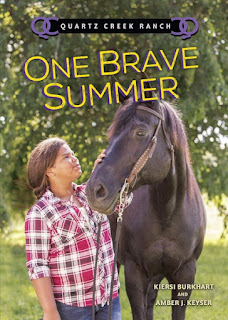
But, save for a single timid riding experience as a child, those state fair run-ins were the extent of my horse experience. (I chased cats and ran away from dogs, which terrified me until a certain age. Horses were probably just too large and inaccessible from my city homes to inspire my affection.)
So when I began editing the Quartz Creek Ranch middle-grade series, coming in January 2017 from Darby Creek, authors Kiersi and Amber had their work cut out for them. Not only would we be in dialogue about story edits and character arcs; they would have to answer question after question from me about horse traits, horse vocabulary, caring for horses, riding horses, horse births... and so on. Thankfully, they are experts in this area, and they had their own experts to turn to when needed.
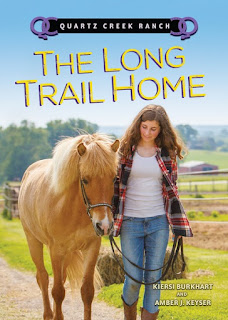
What I loved about the Quartz Creek Ranch series from the start is the unique backdrop Kiersi and Amber gave to each book: a Colorado ranch that works with middle-grade youth going through tough periods, with horseback training as the main goal--which, as it turns out, just happens to impart discipline, social skills, humility, and self-confidence on the side, of course. Quartz Creek Ranch is full of kids who've never ridden a horse before, and some who have . . . though you might be surprised which ones. They come from various family arrangements and backgrounds all across the economic spectrum, from Boston to Texas to California, with a range of reasons for being on the ranch. And Ma Etty and Willard Bridle, the ranch's owners, have a special brand of respect, acceptance, expectation, and wry humor that can disarm any of the youth on their ranch--and, by my estimation, any reader. These aren't typical horse stories because this is not your typical horse ranch.
These are deftly crafted stories of relatable characters facing both internal and external challenges, and their respective horse partners are written with no less personality and wit. Young horse lovers will have plenty of vivid, endearing details to chew on--but this editor is proof that to fall in love with Quartz Creek Ranch, no previous horse interest is necessary.
The authors have been revealing each of the book covers over the past few weeks, and we're thrilled to be unveiling the fourth cover today: AT TOP SPEED.
Here's the lowdown:
For Ella, winning has always been the goal, and at Quartz Creek Ranch, she's pretty sure she'll ace horseback riding too. There's just one hitch in her plan: Figure Eight, the beautiful quarter horse she's paired with, won't listen to a word she says.
Struggling with Figure Eight could be the motivation Ella needs to control her ego and temper—especially when she's turned on to barrel racing. Figure Eight would be incredible at it, she knows. But quiet, sensitive Jordan is the only one on the ranch with time to teach Ella those high-speed turns. Suddenly Ella faces a new challenge on her road to success: figuring out how to be a good friend.
We were incredibly lucky to work with a fabulous photographer for the covers in this series, who founded talented models and--dare I say it--irresistibly gorgeous horses to grace the front of each book. Now we're just excited to get them into readers' hands.
Mark your calendars (and send in your preorders), because all four Quartz Creek Ranch books will be available from Darby Creek on January 1, 2017. Can't wait to hear reactions from horse lovers new and old!

Check out
Vicki Oransky Wittenstein's
new short video about her latest TFCB YA nonfiction title,
Reproductive Rights: Who Decides? For the book. Vicki has done wonderful, in-depth research; interviewed a number of experts and key players; and maintained a perfect objective tone in this overview of reproductive rights through the centuries. The book is a must-have for libraries that aim to provide a solid, information resource on the topic for report writing, for pro/con debates, and for better understanding key arguments in the contemporary discussion of reproductive issues. Vicki's video is an incisive window into what drove her to write the book for TFCB, and the book has been so well received.
Reproductive Rights is a JLG selection, described in the
Booklist starred review as "an impressive resource" that leaves "no stone unturned."

Happy Friday! In honor of the season, we're giving away a copy of a Halloween-appropriate graphic novel: Stone Cold, the first book in the Stone Man Mysteries series by Jane Yolen and Adam Stemple, with illustrations by Orion Zangara.
When young runaway Craig prepares to jump from a church rooftop, his salvation comes in the unholy shape of Silex: a beast trapped in the form of a gargoyle. Silex runs an investigative service, chasing redemption from atop his perch. And he needs a young lad to do his footwork.
Craig begins his new life by probing a series of murders that has menaced Scotland. The scenes are frightening, the motivation is a mystery, and the authorities are no help. So along with Father Harris, a hard-edged man of the cloth, Craig steps onto the streets of Edinburgh—and toward the dangerous task of catching a killer.
Here are three ways you can enter for a chance to win:
- leave a comment on this post that includes your first and last name
- send an email to [email protected] that includes your first and last name
- tweet this line: Tweet for a chance to win STONE COLD from @LernerBooks! bit.ly/1OrSN
US entries only, please. We'll announce the winner on the blog on Friday, October 28. Good luck!


It’s all treats and no tricks here as we speed toward Halloween! My treat today is to introduce you to
It’s Halloween! (cover pictured)—a hot-off-the-presses book from our brand-new line of offerings for PreK–1 readers,
Bumba Books.
It’s Halloween! is part of a six-book Bumba series called
It’s a Holiday! Other books in this set include
It’s Christmas!,
It’s Chinese New Year!, and
It’s Ramadan and Eid Al-Fitr! Each Holiday book walks readers through what the holiday is, how it’s celebrated, what special clothing celebrants might wear, what foods they might eat, and when in the year the holiday falls.
It’s Halloween! includes so many features I just love, such as adorable pumpkin icons on the title page, a smiley face in the brand logo (I mean, really—how cute is that?), a table of contents just big enough to introduce this feature to emergent readers without overwhelming them, and “critical-thinking question” sidebars that encourage them to examine the book’s photos and reflect on what they see.
Speaking of the photos: I adore those too. We see glowing jack-o-lanterns, gourds and corn, kids in costume, and a house decked out with a grinning scarecrow—in other words, all the things we love about Halloween.
The text is clear and simple, with each sentence starting on a new line and printed in a highly accessible font. The book ends with a graphic element showing different ways to carve a pumpkin—also useful for teaching kids about facial expressions and what different expressions mean—a glossary defining words such as
harvest with a helpful accompanying photo, and a basic index and Further Reading section.
It’s Halloween! is the type of “teachable” nonfiction that also makes a really fun read aloud. If you have kiddos in your life who are the right age for Bumba, I encourage you to
treat them to
It’s Halloween! as trick-or-treat day approaches.

By: Amy McGuire,
on 10/18/2016
Blog:
Lerner Publishing Group
(
Login to Add to MyJacketFlap)
JacketFlap tags:
Halloween,
monsters,
series,
creatures,
iBooks,
iBook,
Lerner Interactive Books,
Monster Buddies,
"Lerner Digital",
Add a tag
Special thanks to digital intern McKenna Balzer for the following post!
October 31 marks Halloween, popularly celebrated with trick or treating, pumpkins, costumes, scary stories, and creepy, crawly, undead, slimy creatures emerging for a frightful haunt. But have no fear, after all, monsters aren’t real…right?
Have you ever wondered why ghosts like to play tricks, how to fight a vampire, how long dragons live, or why people became afraid of witches?
In the Lerner Digital Interactive Books series “Monster Buddies,” you will learn more than you ever thought possible about monsters. From a friendly ghost named Pablo to a zombie named Roscoe, every book in this series features a fictitious creature with only one desire: to tell you allabout themselves. In the “Monster Buddies” books, authors Shannon Knudsen and Lisa Bullard create a world where monsters aren’t so scary. Each creature begins their story by ensuring the reader knows there is no such thing as ghosts, zombies, witches, aliens, mummies, dragons, vampires, or werewolves. Readers given the chance to learn all about the monster telling the tale as well as the different variations and origins of the monsters that exist throughout the world.
 Titles in this exciting series include:
Titles in this exciting series include:LernerDigital Interactive Books are designed to help readers gain confidence and improve their literacy skills. Readers can follow along with the narrator through highlighted text with a choice of three speeds of audio. With “Monster Buddies” colorful illustrations and interactive design, exploration of the text is encouraged through a glossary, quizzes, and activities. Readers are given a uniquely exciting experience!
This Halloween, before trekking into the dark night, explore “Monster Buddies” Interactive Books and make friends with all of the creepy Halloween creatures! 
It’s obligatory, guys: the October edition of Books and a Snack just had to feature pumpkin! Now, pumpkin pie is probably my favorite pumpkin treat—but that's a bit elaborate for Books and a Snack, so we'll be making pumpkin pudding instead.
To get started, you'll need:
● a group of pumpkin-loving kids
● some pumpkin-themed books (see below for my personal favs from the Lerner library)
● 1 cup canned pumpkin
● 1 package instant vanilla pudding mix
● 1 teaspoon pumpkin pie spice
● 1 1/4 cups skim or low-fat milk
● 1 cozy reading corner
First, gather up your books so they’re all ready. Set out a big blanket to sit on in your cozy corner. Toss some throw pillows or seating poufs on it too if you want to make it extra cushy.
Next, in a mixing bowl, stir the canned pumpkin, pudding mix, pumpkin pie spice, and milk together. Place the mixture in individual serving bowls and chill it until it sets. Once it’s set, it’s ready to serve! (Hint: It makes four servings.)
Finally, herd your little “pumpkins” over to the cozy corner, hand out the bowls of pumpkin pudding, and read the pumpkin books aloud while the kiddos enjoy some pumpkin-y goodness. You’re the one who gets to lick the spoon (and, hey, maybe the mixing bowl too—no judgment here). After all, you’re the one who whipped up the pudding!





Happy Friday, everyone! Today we're featuring a Goodreads giveaway of Naked '76 by Kevin Brooks.
London, 1976: A summer of creation, destruction, and blistering heat.
Lili Garcia stands at the edge of London's growing punk scene, playing bass with one of the city's wildest bands. The group's success has only strained things between Lili and Curtis Ray, her cool, rebellious boyfriend and bandmate.
Lili soon meets William Bonney—a guitarist from Northern Ireland. William is as reserved as Curtis Ray is loud, haunted by the life he left behind, but every bit as brilliant a musician. William's quiet confidence moves Lili to search for what she really wants. But the secrets of William's past could mean danger for both of them . . .
"[T]hrobs with social and political tensions and the raw drive of punk music. . . . Readers will be swept up in Brooks' adrenaline-fueled story of music and rebellion."�starred,
Booklist Kevin Brooks lives in the UK and is the author of many books for young adults including
The Bunker Diary, winner of the 2014 Carnegie Medal.

Feed the Need to Read!
Lerner's Best of Fall 2016 Webinar
Thursday, October 27, 2016
1:00 p.m. CST
Your readers are hungry for good books! Join us for taste of Lerner’s best fall series and titles for grades K-12. From nutritious easy-reading nonfiction titles to delicious YA novels, we have a bounty of new releases for you to sample.
Throughout the 30-minute webinar, we’ll hold live drawings for six lucky winners to receive a FREE "Feed the Need to Read" lunch bag! Winners will be picked at random from the list of viewers.
Can’t make the date? Register and you'll receive a link to watch an archived video of the webinar when it becomes available.
Register now!

By: Amy McGuire,
on 10/11/2016
Blog:
Lerner Publishing Group
(
Login to Add to MyJacketFlap)
JacketFlap tags:
eBooks,
new,
application,
ebook reader,
program,
app,
Chromebook,
"Lerner Digital",
Chrome web store,
Add a tag
Special thanks to Jeff Mitchell for the following post!
Chromebooks are a wonderful choice for many. Not only are some models among the more accessible and affordable device options out there, they all offer quick and easy regular updates, fast logins, and seamless use of Google cloud services. Combine all that with their simple, intuitive user experience, and it’s no surprise many parents and educators are choosing Chromebooks as a solution to their technology needs.
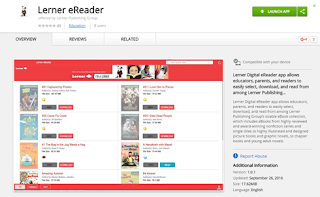 So Lerner Digital is pleased to be one of the first K-12 publishers to offer a Chromebook app: Our new Lerner eReader App for Chromebook is now available for FREE on the Chrome Web Store.
So Lerner Digital is pleased to be one of the first K-12 publishers to offer a Chromebook app: Our new Lerner eReader App for Chromebook is now available for FREE on the Chrome Web Store.
While you can always go online and visit ebooks.lernerbooks.comto enjoy Lerner Digital, the Lerner eReader App for Chromebook puts your Lerner Digital Bookshelf just a click away, providing easy access to thousands of Lerner Digital’s award-winning eBooks and digital products, even offline! So students can now enjoy streamlined book access and more mobility. Designed to deliver robust e-reading, audio, and multimedia capabilities on any Chromebook, the Lerner eReader app makes it easier than ever to enjoy all the eBooks, Interactive Books, and Audisee™ eBooks with Audio Lerner Digital has to offer:
The Girl Who Owned a City: The Graphic Novel, by O.T. Nelson, adapted by Dan Jolley, illustrations by Joelle Jones; originally published as a novel over 40 years ago, we’re excited to offer this ahead-of-its-time story as a stunning graphic novel as part of our Audisee eBooks with Audio.
Happy reading!

I love the challenge of a nonfiction picture book. There's no single best way to present a topic--whether it's community helpers, the many roles water plays in our world, or the life of an individual.
When it comes to picture book biographies, I look for stories we don't already know. Examples of this include One Plastic Bag: Isatou Ceesay and the Recycling Women of the Gambia by Miranda Paul, illustrated by Elizabeth Zunon; The Nutcracker Comes to America: How Three Ballet-Loving Brothers Created a Holiday Tradition by Chris Barton, illustrated by Cathy Gendron; and the forthcoming A Spy Called James: The True Story of James Lafayette, Revolutionary War Double Agent by Anne Rockwell, illustrated by Floyd Cooper.
A Spy Called James comes out on November 1, and it posed some interesting research challenges for Anne Rockwell. In brief, there is not a lot of information out there about James Lafayette. We know that he was born into slavery in Virginia in about 1748 and he was owned by William Armistead. During the American Revolution, James played a significant role as a double agent, providing the Americans key information that led to a defeat of the British at the Battle of Yorktown. After the war, despite his important contributions, James was still enslaved. While the state of Virginia emancipated salves who had enlisted in place of their owners, James had been a spy--not a soldier--so the law did not apply to him.
Thus began James's quest to procure his own freedom. We know about his contributions during the war and his petitions to the Virginia General Assembly for freedom because documentation exists. And so we know that it was not until the Marquis de Lafayette wrote
a letter in support of James that he was finally freed on January 9, 1787. As tribute for what Lafayette did, James took the last name Lafayette.
As far as we know, James Lafayette did not ever write about his own life. Documents show that he married and had at least one son. He also purchased land and owned between one and four slaves at different times. Yes, a former slave owned slaves. Why did he do this? James never said. But
this article by Henry Lewis Gates Jr. offers some possible explanations.
So what is an author to do when she doesn't have as much information as would be ideal? One option is to simply move on to another, better documented topic. But the problem is that very often the lives of marginalized people are not as well documented as those of white, wealthy people.
When Vaunda Micheaux Nelson couldn't find all the information she needed to write a nonfiction book about her great uncle, Lewis Michaux, she instead wrote
No Crystal Stair: A Documentary Novel of the Life and Work of Lewis Michaux, Harlem Bookseller.
In this case, Anne Rockwell shaped a story around the parts of James's life that we know the most about. And Floyd Cooper created gorgeous artwork to breathe life into that story.
I will never know everything I want to know about James Lafayette. But what I do know has helped to give me a broader perspective on the lives of enslaved men during and after the Revolutionary War. While James's life is not without complications, I hope that young readers can also find inspiration in his quest for freedom.

This season, we're excited to launch our new PreK-1 nonfiction brand,
Bumba Books™! When we were planning the brand, we wanted to add something fun and charming to what’s available at the emergent level. We focused on bright colors, friendly text, and even a logo with a touch of silly.
On the editorial side, we paid extra attention to a few key components in these books: carefully leveled text, attractive and informative pictures, text-to-photo match, and critical thinking questions.
We worked hard to find imagery that shows people, especially kids, to help readers connect with the books. For books like these, we normally write and edit text first, then find images to match. Close text-to-picture match is really important for early readers, so we made a special effort to tie these items as closely together as we could. We carefully researched images and chose those that most closely matched the text and would be of particular interest to readers.
A feature of these books that is distinct from other books for this age level is the critical thinking questions, which are closely tied to both the image and the text on the spread. Sometimes these were tricky, because critical thinking questions are different from, say, recall questions. Our authors and editors included questions that encourage readers to interact with both the text and the photos. For more resources on teaching critical thinking, visit the
Bumba Books page on our website.
We worked closely with a reading consultant to ensure Bumba Books was on target for emergent readers. We think it’s an ideal foundational brand to help readers build a love of nonfiction and reading.
You can start reading a Bumba Books title today by accessing a free Bumba Books Interactive Book
here. We can’t wait to hear what you think!

By: Amy McGuire,
on 10/4/2016
Blog:
Lerner Publishing Group
(
Login to Add to MyJacketFlap)
JacketFlap tags:
new releases,
eBook,
disasters,
cause and effect,
natural disaster,
Investigation,
Chicago Fire,
"Lerner Publications",
"Lerner Digital",
fall 2016,
A Cause-and-Effect Investigation,
The Great Chicago Fire,
Add a tag
Special thanks to Kris Vetter for the following post!
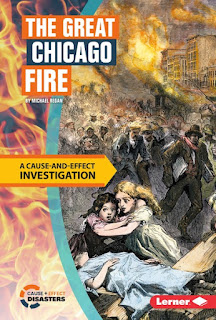
This Saturday, October 8, marks the 145
th anniversary of the Great Chicago Fire.
In 1871, a fierce fire broke out in the bustling city of Chicago. Legend has it that Mrs. O’Leary’s cow kicked over a lantern in her barn, but newspaper reporters later admitted that they made up the story. However, experts agree that the fire started near the O’Leary’s barn around 8:30 in the evening.
The fire jumped rivers and burned miles of buildings and homes, which were mostly constructed of wood and highly flammable shingle and tar roofs. The flames raged for more than two days. More than a hundred people died, and thousands were left homeless. In order to understand the impact of this disaster, you must understand its causes. How did Chicago's building methods add fuel to the fire? How did human error delay help when the fire broke out?
All titles are available in print, PDF, epub, and kf8 formats from
LernerBooks.comand other retailers.

Welcome to October, everybody! It’s always been my favorite month. I love the gorgeous changing leaves; the crisp, cool weather; and those cozy early nights that start with orangey, autumny sunsets and that unmistakable scent of fall-turning-to-winter in the air.
There are lots of other things to celebrate in October too. And Lerner has a book for them all! Here’s a look at October holidays and special days, and a book to help you celebrate each one:
October 1 was World Vegetarian Day. Yes, we’ve passed it, but as a vegetarian myself, I just couldn’t let this one slip by without a mention. (Smiles!)

October 3 (today!) brings Rosh Hashanah. Sending out wishes for a very Happy New Year to all those who celebrate.

October 7 is World Smile Day!

October 10 is Canadian Thanksgiving. Happy Thanksgiving to all our neighbors to the north.

October 12 is Yom Kippur.

October 15 is Teacher’s Day. To all you teachers, librarians, and others who do the noble work of educating children: Thank you so much for everything you do.

October 16 has a Full Moon.

October 17 is the first full day of Sukkot. Wishing a joyous Sukkot to everyone observing it!

October 22 is Make a Difference Day.

October 30 is National Candy Corn Day. Set out a bowl and offer some to any passers by as a pre-Halloween treat.

October 31 is Halloween!

Wishing all of you a happy, healthy, and very fun October!

View Next 25 Posts



















